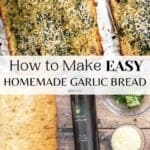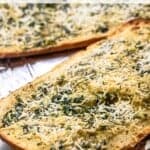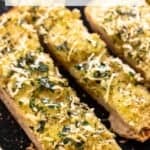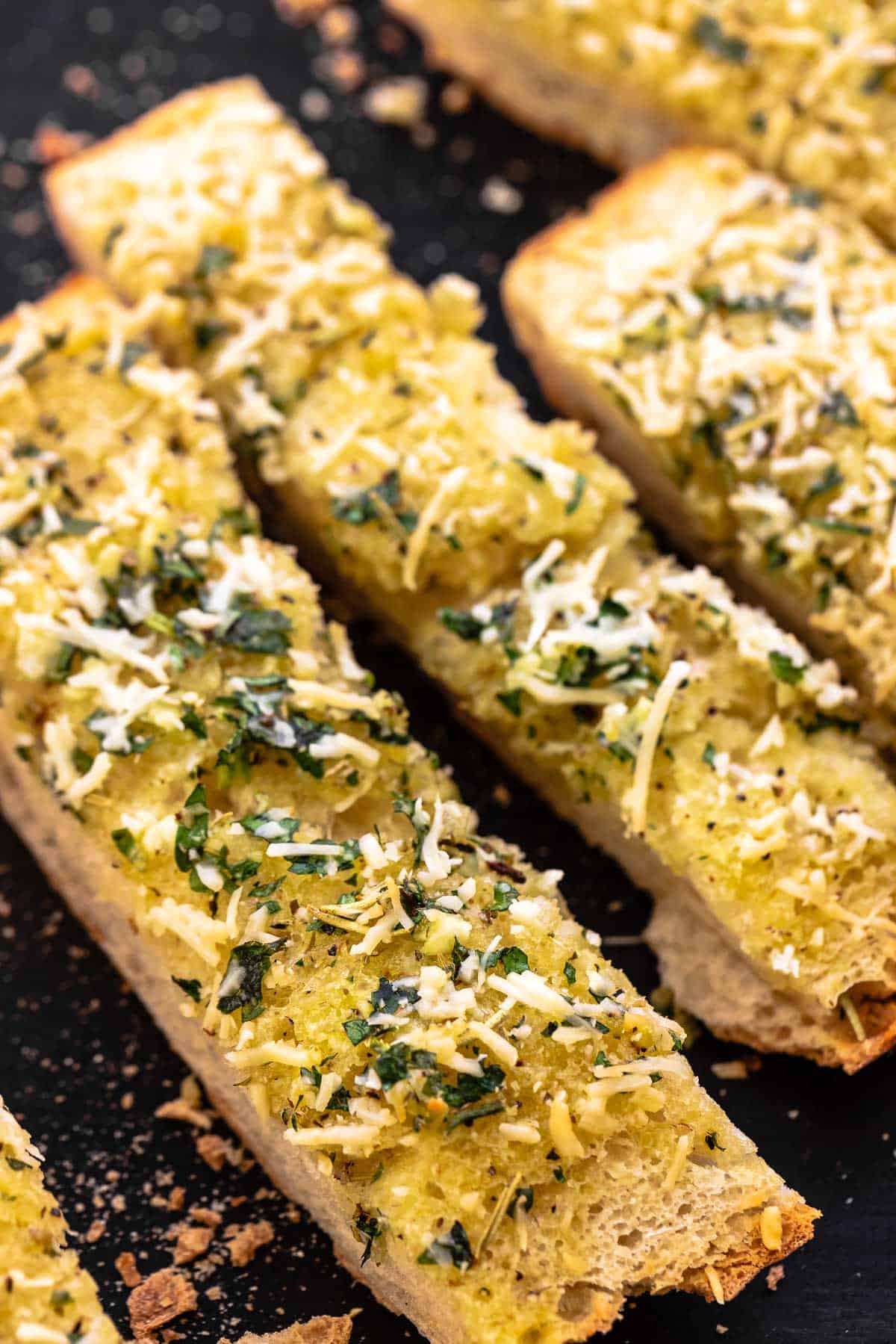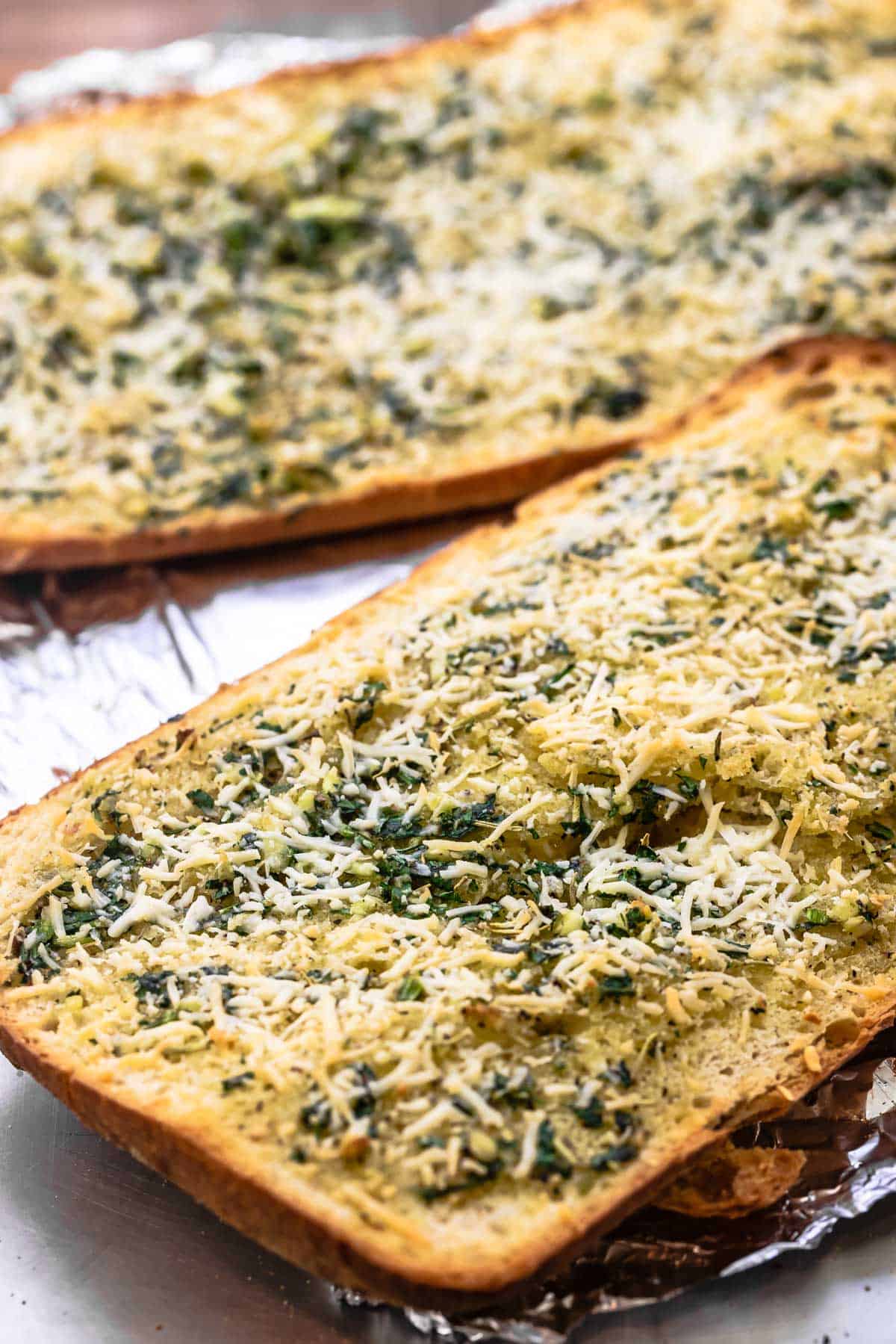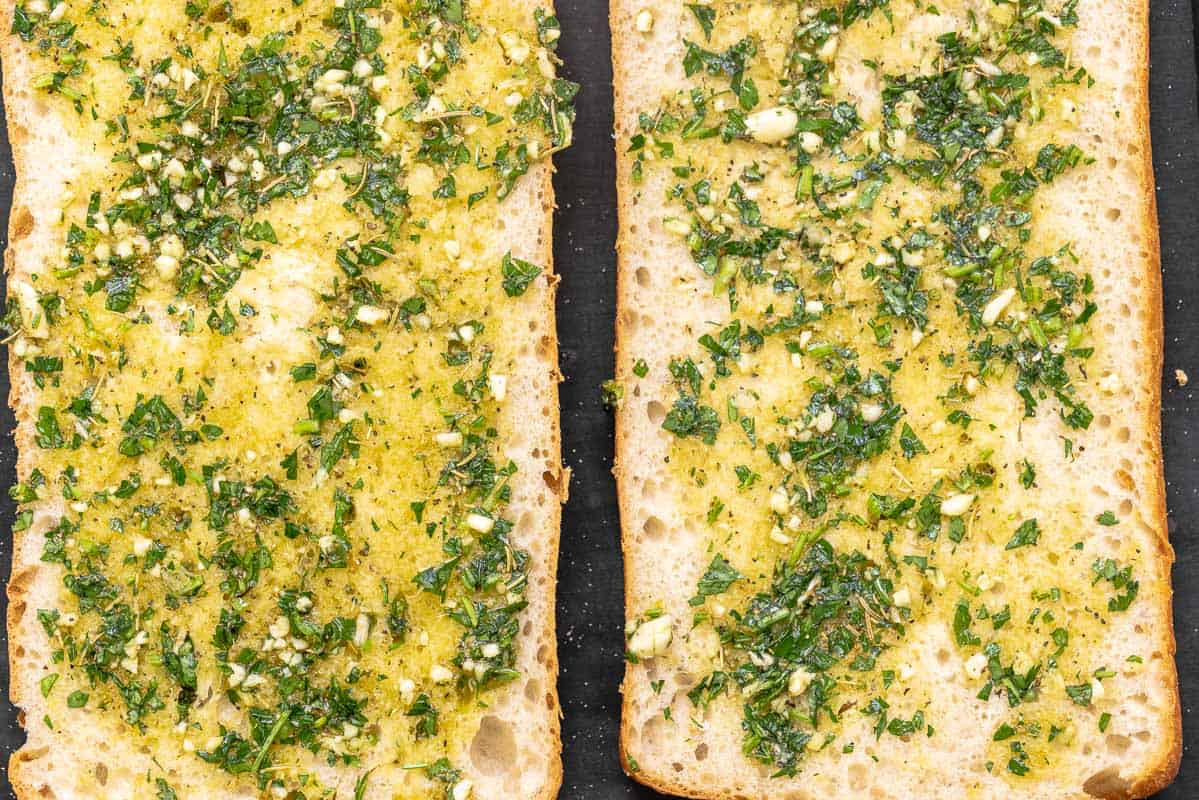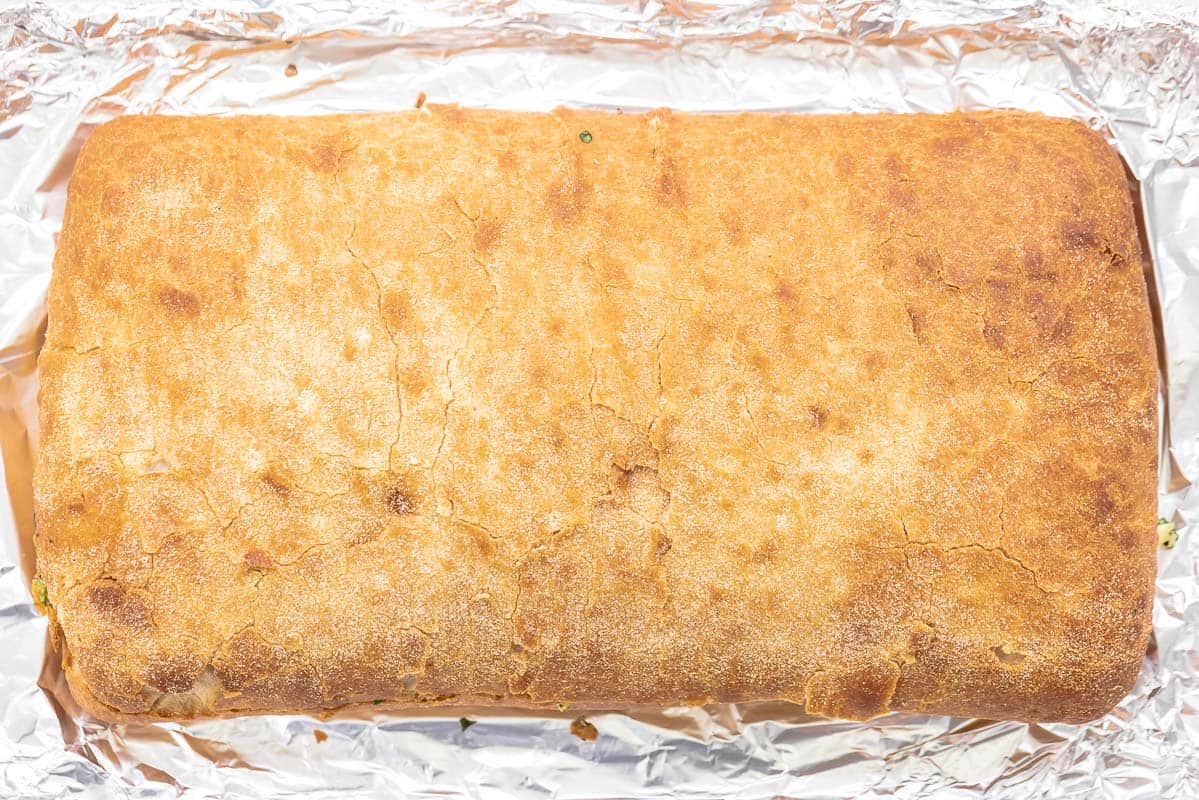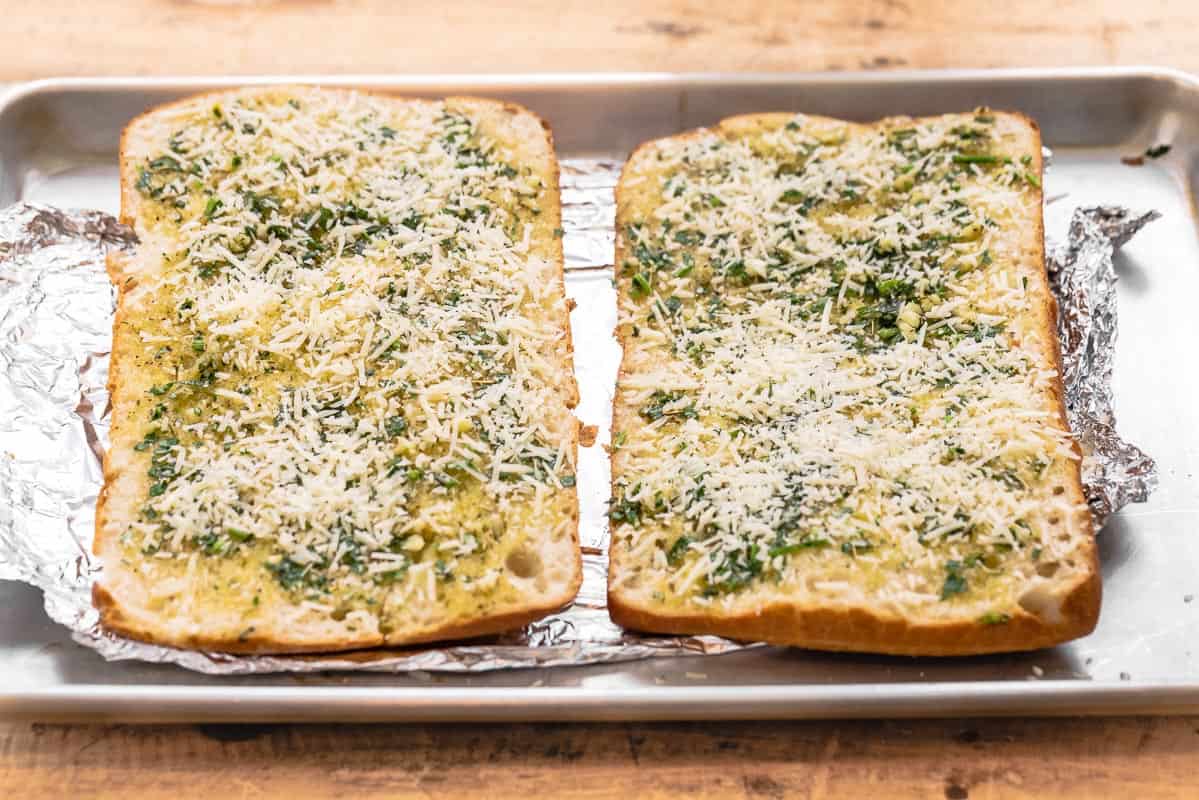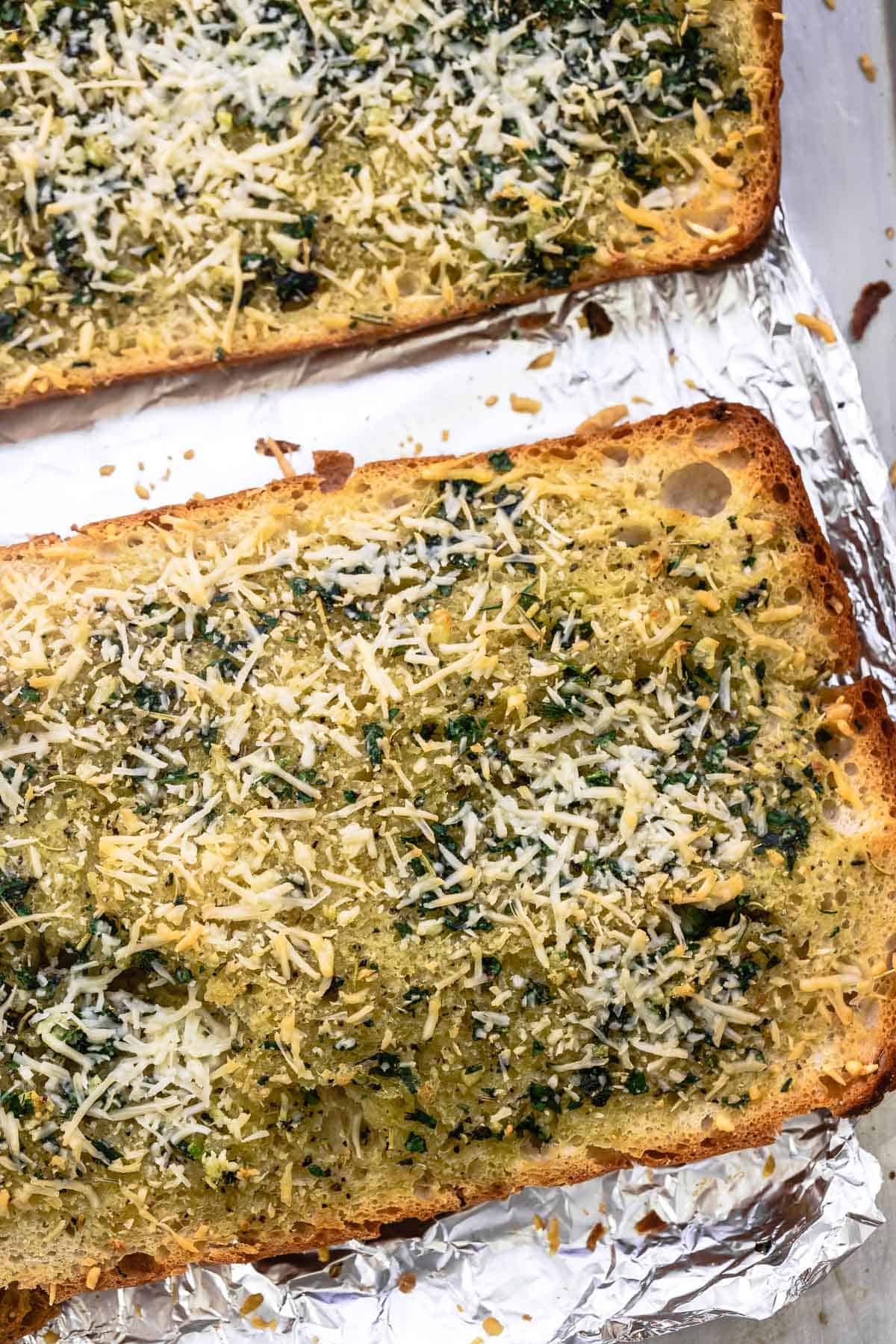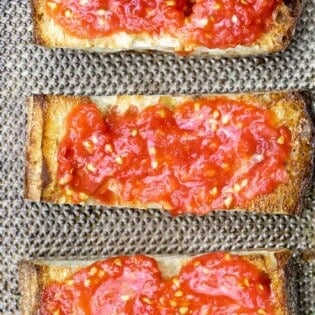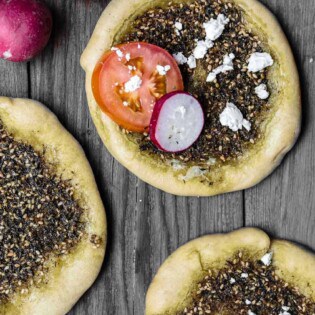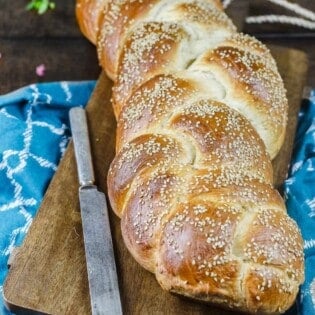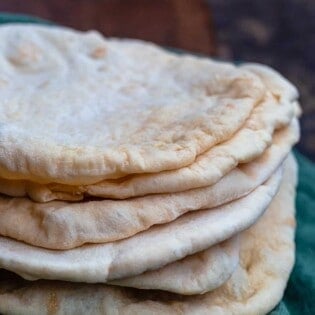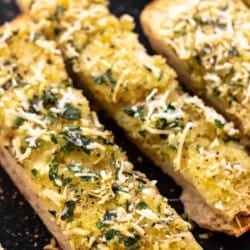Garlic bread is one of the easiest little appetizers to make, yet I’ve eaten my fair share of greasy, limp garlic bread. Even worse, I’ve had some where the bread had an okay bite, but the garlic was too burned and bitter, leaving an unpleasant taste in my mouth. Have you been there? If you’re after an easy recipe for how to make garlic bread perfectly every time, this one is for you!
The secret to perfectly crispy homemade garlic bread
This ciabatta garlic bread recipe starts with a simple olive oil sauce made of good extra virgin olive oil, garlic, and herbs. You’ll apply the olive oil sauce to your bread using a brush – this will evenly spread the olive oil on the bread, giving it good flavor and ensuring the best texture, none of that greasy stuff. And to achieve that “crunchy on the outside, chewy on the inside” result we’re all looking for, and without burning the garlic (very important), you’ll first wrap the loaf of bread in foil to bake for the first 10 minutes. Then, you’ll unwrap it to finish baking with the “flesh” side of the bread exposed. (I like to add a sprinkle of parmesan cheese at this point before putting the bread back in the oven, but you can omit the cheese for a vegan option.) When you see lightly charred edges on your homemade garlic bread, and bits of the cheese turning a nice golden brown, your bread is ready!
Best bread to make garlic bread
I used a loaf of ciabatta bread (about 1 pound). Traditionally, ciabatta is baked with a hard crust while maintaining a softer texture on the inside. Shaped like a slipper, hence the name “ciabatta,” it’s a sturdy bread that offers a wide, flat surface (wider than French baguette), so it offers more room to spread my herby olive oil, plus the holes in the bread are perfect for catching the bits of garlic and herbs for great flavor.
If you can’t find ciabatta, any rustic long loaf bread or French baguette will still work in this garlic bread recipe. Your baking time may vary a little depending on the bread you choose.
Ingredients: what you need to make garlic bread at home
Bread- Look for a long loaf of ciabatta, French baguette or something similar. Day-old bread is okay too, if you have some to use up. Italian parsley – Also called flat-leaf parsley. Trim off some of the excess stem, but not all of it. Dried rosemary – Peppery, piney rosemary pairs well with the other flavors in the pungent oil. Dried oregano – Adds earthiness and a hint of spiciness. Garlic – You need 4 to 5 large peeled garlic cloves, but adjust the amount depending on how garlicky you want the garlic bread. Extra virgin olive oil – I used our Italian Nocellara EVOO, which is a medium-intensity oil with a delicious, subtle aroma of freshly picked tomatoes. If you like something more intense and peppery, try our Greek Early Harvest EVOO.
How to make garlic bread
With just a few ingredients, you can have homemade garlic bread in 20 minutes or so! Here’s how you make it (printer-friendly recipe below):
Make the garlic and herb oil. Add ½ cup flat-leaf parsley, 1 teaspoon each dried oregano and dried rosemary, and 4 to 5 whole cloves of garlic to a small food processor. While it blends, drizzle in 1/3 cup extra virgin olive oil. Once blended (it does not need to be a totally smooth mixture), season the garlic oil with a little kosher salt and black pepper. Prepare the ciabatta loaf. Place a 1-pound loaf of ciabatta on a cutting board and slice the bread in half horizontally. Place your non-dominant hand on the bread as you slice to keep it in place. Spoon the herby olive oil mixture onto both halves of the bread and spread it all over. Put the halves back together, so the crust is facing outward and the oil-covered sides are touching each other. Grab a large sheet pan and line it with aluminum foil. Place the bread on the pan and cover with another sheet of foil. Close the foil edges together so the bread is completely covered in foil. Bake the homemade garlic bread. Bake the rosemary garlic ciabatta bread on the center rack of a 400 degrees F heated oven for 10 minutes. Remove from the oven and remove the top piece of foil so the bread is uncovered. Separate the bread halves and place them side by side on the sheet pan, oil side up. Sprinkle ¼ cup grated or shredded parmesan cheese onto each half. (You’ll need ½ cup total parmesan cheese.) Return the garlic bread to the oven and bake for another 10 or so minutes, until the bread has crisp, golden-brown edges and the cheese is also slightly golden. Serve. Cut the ciabatta garlic bread into 1-inch slices and serve warm.
Tips for the best garlic bread
Select the right bread. Ciabatta, French baguette, or another long loaf of bread with a good crust and chewy texture on the inside is good to use in this recipe. Ditch the butter and use extra virgin olive oil instead to brush your bread. Olive oil will give you a lighter garlic bread that is perfectly crunchy and not greasy or limp. Use the right amount of garlic. I found that about 4 large cloves per 1-pound loaf of bread gives good flavor without overwhelming the bread. Play with the amount to your liking, but 3 to 4 cloves is a good place to start. Use fresh garlic, not the pre-minced stuff in jars. I don’t advise using pre-minced jarred garlic because it often tastes bitter and sharp, not spicy and vibrant like fresh garlic.Since you pop the cloves into a blender whole anyway, there is virtually no prep for the garlic aside from peeling it. Wrap the bread in foil for a crunchy outside and chewy inside. By baking the bread in foil for the first 10 minutes, you allow the ciabatta to soften, which will give you a pillowy, chewy inside. Wrapping the bread also keeps the garlic from burning. Unwrapping the bread and baking it more adds color and will crisp up the crust for the perfect crunchy outside. Freshly grate or shred the parmesan cheese. I don’t recommend buying bagged grated parmesan or powdered parmesan. Both are very dry, and taste quite different to freshly grated parmesan, which is rich and nutty.
Vegan garlic bread option
By swapping out parmesan cheese for nutritional yeast, you can easily turn this recipe into vegan garlic bread. Follow the recipe as is, but instead of sprinkling parmesan cheese, sprinkle ½ to 1 tablespoon of nutritional yeast on each half of your ciabatta. Since this garlic bread recipe uses extra virgin olive oil instead of butter, the rest of the recipe stays the same. Alternatively, since so little cheese is used, you can leave it out altogether. The garlic bread will taste just as rich and flavorful! If you want something a little different that is vegan from the get-go, try out my focaccia recipe with garlic and rosemary!
Serve garlic ciabatta with
This easy garlic bread recipe is the perfect starter to a comforting Italian dinner like cacio e pepe, spaghetti puttanesca, chicken piccata, scallop pasta or shrimp fra diavolo. By itself, it’s great with my homemade spaghetti sauce for dipping. And if you like, ciabatta garlic bread makes a great vehicle to sop up thick sauces or soups and stews, like Crockpot beef stew, sausage and lentil stew, meatball soup, and tomato basil soup.
Can I freeze homemade garlic bread? Storage tips
Yes, you can freeze garlic bread! In fact, freezing is the best option to store garlic bread long-term. Wrap the bread in foil and place it in freezer-safe zip-top bag for up to 3 months. To reheat, place garlic bread on a baking sheet (directly from the freezer; no need to thaw) and warm in a 375 degrees F heated oven until hot and crispy. If you know you’ll be finishing up any leftovers within a few days, keep the homemade garlic bread on your kitchen counter. Garlic bread can be kept at room temperature, wrapped in foil, for 2 days. It should not be refrigerated. It sounds counterintuitive, but refrigerating garlic bread dries it out faster and makes it stale.
More bread recipes
Browse more Mediterranean recipesVisit Our Shop
Pan Con Tomate (Spanish Tomato Bread)
Za’atar Manaqish Recipe
Easy Challah Bread Recipe
Easy Homemade Pita Bread Recipe
